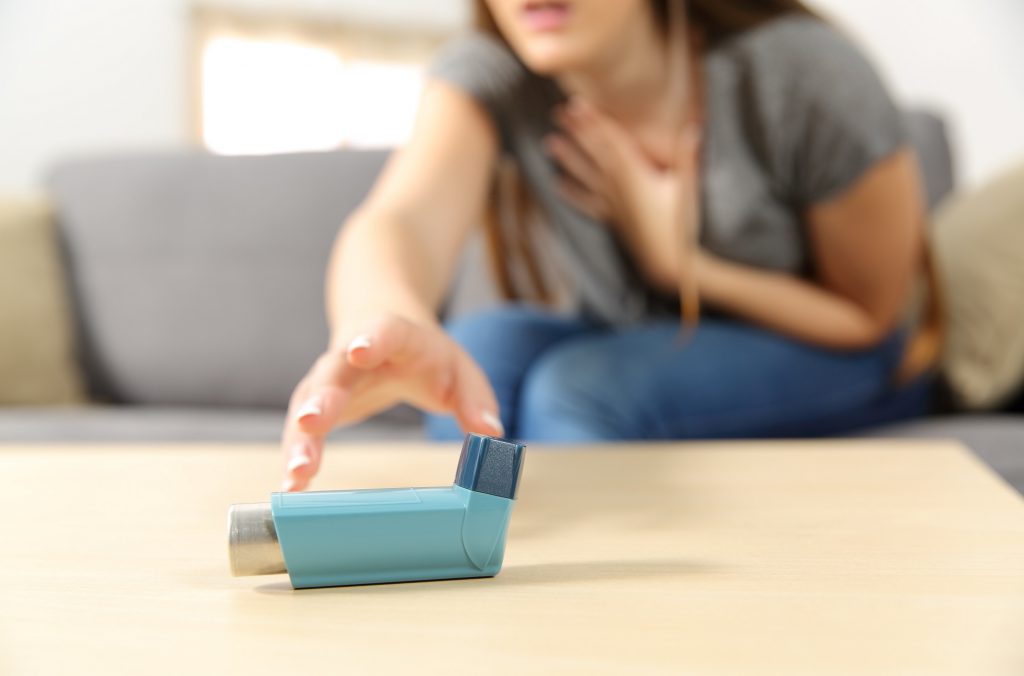May 4, 2021
WHAT IS ASTHMA?
Asthma is a chronic inflammatory disease of the bronchi that manifests itself by: attacks of shortness of breath, coughing, wheezing, and sometimes permanent difficulty in breathing. Asthma results from the association of a genetic predisposition to allergy and favorable environmental factors, such as pollen, dust mites, animal dander and hair, cockroaches, mold, etc. Although there is often a family predisposition to the onset of asthma, its transmission from parents to their children is not systematic.
In a person with asthma, the bronchi are abnormally sensitive to certain factors such as exercise, cold, cigarette smoke or exposure to substances that cause an allergic reaction (allergens). This greater sensitivity (“hyper-reactivity”) of the bronchi is the consequence of their permanent inflammation. When inflamed bronchi are attacked (by allergens, smoke, cold, dry air, pollution, etc.), they react by contracting and producing mucus. This reaction interferes with the passage of air in the bronchi: it is an asthma attack.
Globally, the proportion of asthmatics in the population is estimated at around 5% of adults and 10% of children, or 200 million asthmatics on our planet.
All countries are affected. The frequency of the disease is increasing in all countries, as is that of allergy, with stronger growth in industrialized countries where the number of asthmatics has doubled in the last fifteen years.

Many factors can be the cause of an asthma attack in people prone to this disease: allergies to dust mites, cockroaches, animal hair, etc. Other causes are less well known but there are more and more allergies to other animals (rodents, birds, etc.), to indoor plants (ficus, flower pollens, etc.), sometimes to food for aquarium fish (bloodworms or chironomids).

THE BASIC TREATMENT OF ASTHMA
By maintaining optimal opening of the bronchi, disease-modifying asthma treatments restore airflow and therefore improve respiratory function. The disease-modifying treatment also helps prevent the onset of permanent and disabling respiratory failure.
Medicines prescribed for the maintenance treatment of asthma have very few or no side effects if used at the lowest effective doses (i.e. the lowest dose that can effectively control asthma). To find these minimum effective doses, gradual dose reduction is often offered in three month increments once asthma is under control.
The mainstay of asthma treatment is aimed at preventing or limiting the occurrence of attacks. It does not work immediately and to be effective it must be taken every day. Two families of drugs are mainly used in the maintenance treatment of asthma: corticosteroids, strong anti-inflammatory drugs, and long-acting bronchodilators. Their use in inhaled form allows them to be delivered directly into the lungs and to avoid side effects on the body.
Other medicines are also offered as alternatives: montelukast, prolonged-release theophylline, tiotropium and, after specialist advice, omalizumab, benralizumab, mepolizumab or reslizumab.

TREATMENTS FOR ASTHMA ATTACK
An asthma attack requires prompt treatment to dilate the bronchi, to increase air circulation in the lungs, and to reduce inflammation in the bronchi.
FAST-ACTING BRONCHODILATORS IN INHALED FORM
Fast-acting bronchodilators work by relaxing the muscles around the bronchial tubes, making it easier for air to pass and providing quick relief from breathing. Their action is rapid (a few minutes) and limited in time (four to six hours).
WHAT CONDUCT TO TAKE DURING AN ASTHMA ATTACK?
During an asthma attack, the action to take varies depending on whether it is an attack that stops quickly or not.
AT THE BEGINNING OF THE ASTHMA ATTACK
At the first signs (shortness of breath, chest tightness, cough, etc.), the usual treatment is two puffs (if it is a metered-dose inhaler) or one inhalation (in the case of a powder inhaler) a fast-acting beta-2 mimetic bronchodilator.
After ten to fifteen minutes, if the discomfort persists, you can take two puffs of metered-dose aerosol or one inhalation of powder.
After another ten to fifteen minutes and if the symptoms still have not gone away, you can take another two to four puffs of the spray, or one to two inhalations of powder.
A simple attack should stop after taking six to eight puffs of aerosol (or three or four inhalations of powder).
It is also necessary to eliminate the possible triggering factors: allergens, cigarette smoke, cold, etc.
IF THE ASTHMA ATTACK IS RESISTANT TO TREATMENT
If there is no improvement after inhaling six to eight puffs of aerosol (or three or four inhalations of powder) of beta-2-mimetic bronchodilators, if the peak expiratory flow (PEF) is less than 50% of the reference value or if the crisis starts again quickly, it is a so-called “severe” crisis. It is then necessary simultaneously:
- increase the doses of beta-2 mimetic bronchodilators by inhalation or subcutaneous injection;
- take corticosteroids in tablets (according to the dose prescribed by the doctor);
- notify a doctor immediately.
If there is no improvement, or if there is a real feeling of suffocation from the outset, consider this to be a severe acute asthma, and call a medical intervention team at home. Severe acute asthma attacks usually require corticosteroid injections for a few days. In all cases, it is necessary to find and treat the triggering factor in question: exposure to an allergen, infection, cold, smoke, etc.

